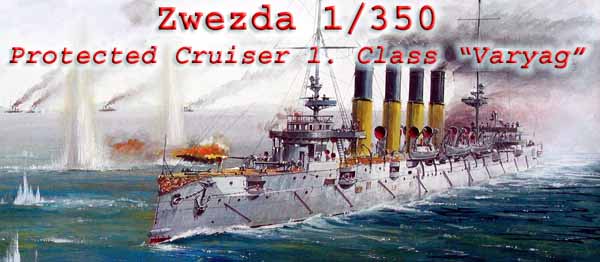Protected Cruiser 1. Class “Varyag” (Viking) in 1/350.

Especially above 1/700 we had been left with little to choose from in plastic kits. Trumpeter stirred the bucket quite a bit, when they started “going big” releasing carrier after carrier in 1/350 an finally a BB-55. With all the plastic avalanche coming form the Far East these days, other companies’ releases seem to go unnoticed. Russian maker Eastern Express released a 1/350 Borodino, but I didn’t see any review about that kit, even though the number of pre-dreadnaught-fans does not seem to be too small. Hasegawa’s release of 1/350 Mikasa seems to be drawing some attention. Rumours about the first production run being “sold out” are already circling. Fitting the topic “Russo-Japanese War”, Zwezda from Russia just released their
Protected Cruiser 1. Class “Varyag” (Viking) in 1/350.

I hope to be able to draw some attention to this kit to encourage these
makers to proceed on their off-the-beaten-track policy.
| Laid down: | 1898, Philadephia, USA |
| Launched: | 1899 |
| Commissioned: | January 14, 1901 |
| Fate: | - Scuttled February 9, 1904 after the Battle of Chemulpo (Incheon, Korea) - Raised, repaired and used as training ship “Soya” by Japan after the war and sold back to Russia in April 1916 - Seized by British government in 1917 while under repair at Liverpool - used as a hulk until ran aground and sold for scarp to Germany in 1922/1923 (dates vary according to source) |
| Displacement: | 6500t |
| Length: | 129.6m (419.6ft)(in scale: 37.0cm/14,84’’) |
| Beam: | 15.8m (52.2ft)(in scale: 4.5cm/1,77’’) |
| Draft: | 6.3m (22,6ft)(in scale: cm) |
| Armament: | 12-6in (152mm), 12-75mm, 6-47mm, 6torpedo launchers |
| Speed: | 23kts |
| Complement: | 550/580 (numbers vary according to source) |
Guido
Hopp
Hilden, Germany
27.06.2005